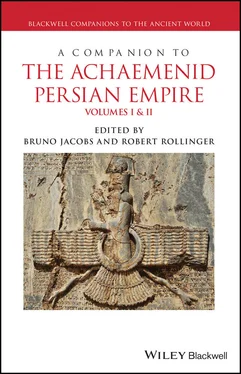It should be pointed out that, in all honesty, these arguments are likewise more probabilities than conclusive proof. There is room for interpretation, in any case: one may or may not agree on the applicability of the “secondary state formation” model and its implications for the Zagros region. Likewise, one may find the terminology of the Nabonidus inscriptions too vague or too obviously following Neo‐Babylonian preconceptions of Medes as “barbarians” to be helpful, or even doubt the historical value of biblical texts in general. The synonymity of “Medes” and “Persians” for Greeks could be explained in a different way: the relationship between Persians and Medes could still be conceived as one between vassals and overlords, and, finally, the new interpretation of Nabonidus Chronicle ii 16 could be challenged.
Still, taken together with negative evidence for a Median “empire,” the evidence presented in favor of a loose confederation of peoples does seem to comprise a sustainable basis for this hypothesis. It must, of course, remain a hypothesis, but one with a relatively coherent and dense line of argumentation that is more plausible than previous explanations.
1 Adali, S.F. (2011). The Scourge of God: The Umman‐Manda and Its Significance in the First Millennium BC State Archives of Assyria Studies 20. Helsinki: The Neo‐Assyrian Text Corpus Project.
2 Bagg, A. (2020). Die Orts‐ und Gewässernamen der neuassyrischen Zeit, Teil 3: Babylonien, Urarṭu und die östlichen Gebiete. RGTC 7/3. Wiesbaden: Ludwig Reichert.
3 Bichler, R. (2000). Herodots Welt: Der Aufbau der Historie am Bild der fremden Länder und Völker, ihrer Zivilisation und ihrer Geschichte Antike in der Moderne. Berlin: Akademie Verlag.
4 Boucharlat, R. (1998). À la recherche d’Ecbatane sur Tepe Hegmataneh. Iranica Antiqua, 33, pp. 173–186.
5 Brown, S.C. (1986). Media and secondary state formation in the Neo‐Assyrian Zagros: an anthropological approach to an Assyriological problem. Journal of Cuneiform Studies, 38, pp. 107–119.
6 Daryaee, T. (ed.) (2012). The Oxford Handbook of Iranian History. Oxford: Oxford University Press.
7 Degen, J., Rollinger, R. (2020). How Greek the Medes were? Herodotus’ medikos logos, Athens and the transformation of empire from symmachia to arche. In S. Badalkhan, G. P. Basello, and M. De Chiara (eds.), Iranian Studies in Honour of Adriano V. Rossi. Naples: UniorPress, pp. 273–289.
8 Fuchs, A. (2011). Das Osttigrisgebiet von Agum II. bis zu Darius I. (ca. 1500 bis 500 v. Chr.). In P.A. Miglus, S. Mühl (eds.), Between the Cultures: The Central Tigris Region from the 3rd to the 1st Millennium BC Heidelberger Studien zum Alten Orient 14. Heidelberg: Heidelberger Orientverlag, pp. 29–320.
9 Fuchs, A. (2014). Die unglaubliche Geburt des neubabylonischen Reiches oder: Die Vernichtung einer Weltmacht durch den Sohn eines Niemand. In M. Krebernik and H. Neumann (eds.), Babylonien und seine Nachbarn in neu‐ und spätbabylonischer Zeit. Alter Orient und Altes Testament 369. Münster: Ugarit‐Verlag, pp. 25–72.
10 Gopnik, H. (2011). The Median citadel of Godin Period II. In H. Gopnik, M.S. Rothman (eds.), On the High Road: The History of Godin Terpe, Iran. Costa Mesa: Mazda Publishers, pp. 285–364.
11 Grayson, A.K. (2000). Assyrian and Babylonian Chronicles Reprinted Texts from Cuneiform Sources 5. Locust Valley, NY: J.J. Augustin.
12 Gufler, B. (2016). Deiokes, Ekbatana und das Land der Meder. Kaskal, 13, pp. 185–207.
13 Henkelman, W.F.M. (2003). Persians, Medes and Elamites: acculturation in the Neo‐Elamite period. In G.B. Lanfranchi, M. Roaf, and R. Rollinger (eds.), Continuity of Empire (?): Assyria, Media, Persia History of the Ancient Near East/Monographs 5. Padova: S.a.r.g.o.n., pp. 181–231.
14 Jursa, M. (2003). Observations on the problem of the Median “Empire” on the basis of Babylonian sources. In G.B. Lanfranchi, M. Roaf, and R. Rollinger (eds.), Continuity of Empire (?): Assyria, Media, Persia History of the Ancient Near East/Monographs 5. Padova: S.a.r.g.o.n., pp. 169–179.
15 Kienast, B. (1999). The so‐called ‘Median Empire’. Bulletin of the Canadian Society for Mesopotamian Studies, 34, pp. 59–67.
16 Lanfranchi, G.B. (2003). The Assyrian expansion in the Zagros and the local ruling elites. In G.B. Lanfranchi, M. Roaf, and R. Rollinger (eds.), Continuity of Empire (?): Assyria, Media, Persia History of the Ancient Near East/Monographs 5. Padova: S.a.r.g.o.n., pp. 79–118.
17 Lanfranchi, G.B. (2021). Training for Empire: the Assyrian Pressure on Western Iran (IXth–VIIth cent. BC). In T. Daryaee and R. Rollinger (eds.), Iran from the beginnings to the Achaemenid‐Persian empire (Proceedings of the First and Second Payravi Conference on Ancient Iranian History). Classica et Orientalia, Wiesbaden: Harrasowitz, in press.
18 Lanfranchi, G.B., Roaf, M. and Rollinger, R. (eds.) (2003). Continuity of Empire (?): Assyria, Media, Persia History of the Ancient Near East/Monographs 5. Padova: S.a.r.g.o.n.
19 Liverani, M. (2003). The rise and fall of media. In G.B. Lanfranchi, M. Roaf, and R. Rollinger (eds.), Continuity of Empire (?): Assyria, Media, Persia History of the Ancient Near East/Monographs 5. Padova: S.a.r.g.o.n., pp. 1–12.
20 Matthew, W. (2017). Ctesias’ Persica in Its Near Eastern Context. Wisconsin: The University of Wisconsin Press.
21 Meier, M., Patzek, B., Walter, U., and Wiesehöfer, J. (eds.) (2004). Deiokes, König der Mede: Eine Herodot‐Episode in ihren Kontexten Oriens et Occidens 7. Stuttgart: Steiner Verlag.
22 Panaino, A. (2003). Herodotus I, 96‐101: Deioces' conquest of power and the foundation of sacred royalty. In G.B. Lanfranchi, M. Roaf, and R. Rollinger (eds.), Continuity of Empire (?): Assyria, Media, Persia History of the Ancient Near East/Monographs 5. Padova: S.a.r.g.o.n., pp. 327–338.
23 Payne, A., Wintjes, J. (2016). Lords of Asia Minor: An Introduction to the Lydians Philippika: Marburger altertumskundliche Abhandlungen 93. Wiesbaden: Harrassowitz.
24 Potts. D.T. (ed.) (2013). The Oxford Handbook of Ancient Iran. Oxford: Oxford University Press.
25 Radner, K. (2003). An Assyrian view on the Medes. In G.B. Lanfranchi, M. Roaf, and R. Rollinger (eds.), Continuity of Empire (?): Assyria, Media, Persia History of the Ancient Near East/Monographs 5. Padova: S.a.r.g.o.n., pp. 37–64.
26 Roaf, M. (2003). The Median dark age. In G.B. Lanfranchi, M. Roaf, and R. Rollinger (eds.), Continuity of Empire (?): Assyria, Media, Persia History of the Ancient Near East / Monographs 5. Padova: S.a.r.g.o.n., pp. 13–22.
27 Rollinger, R. (1993). Herodots Babylonischer Logos: Eine kritische Untersuchung der Glaubwürdigkeitsdiskussion an Hand ausgewählter Beispiele: Historische Parallelüberlieferung – Argumentationen – Archäologischer Befund – Konsequenzen für eine Geschichte Babylons in persischer Zeit Innsbrucker Beiträge zur Kulturwissenschaft 84. Innsbruck: Verlag des Instituts für Sprachwissenschaft.
28 Rollinger, R. (1999). Zur Lokalisation von Parsumaš und zu einigen Fragen der frühen persischen Geschichte. In Zeitschrift für Assyriologie und Vorderasiatische Archäologie, 89, 115–139.
29 Rollinger, R. (2003a). The Western expansion of the Median “Empire”: a re‐examination. In G.B. Lanfranchi, M. Roaf, and R. Rollinger (eds.), Continuity of Empire (?): Assyria, Media, Persia History of the Ancient Near East/Monographs 5. Padova: S.a.r.g.o.n., pp. 289–320.
30 Rollinger, R. (2003b). Kerkenes Dag˘ and the Median “Empire”. In G.B. Lanfranchi, M. Roaf, and R. Rollinger (eds.), Continuity of Empire (?): Assyria, Media, Persia History of the Ancient Near East/Monographs 5. Padova: S.a.r.g.o.n., pp. 321–326.
Читать дальше












